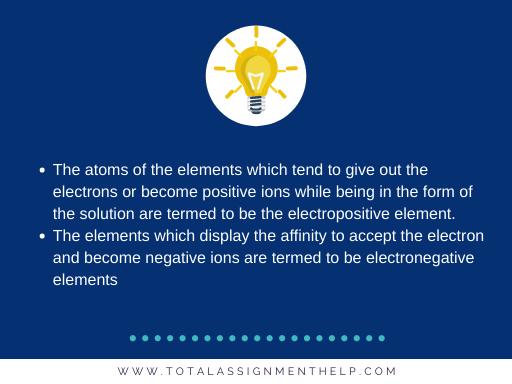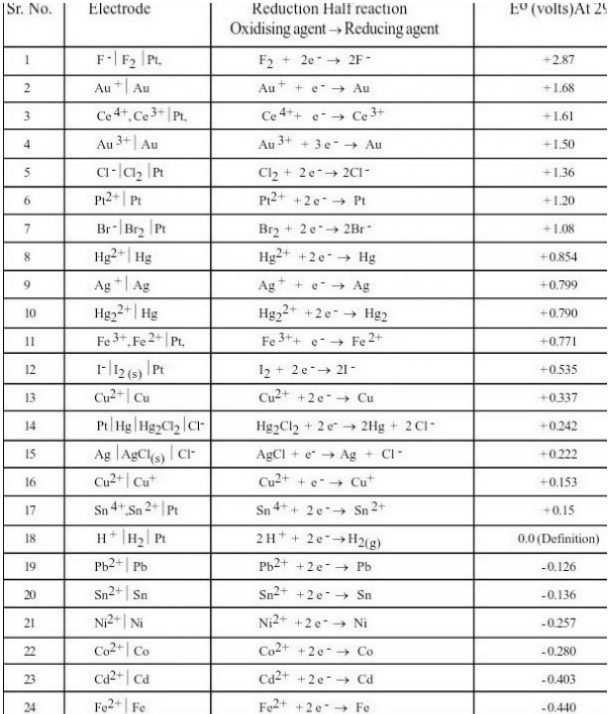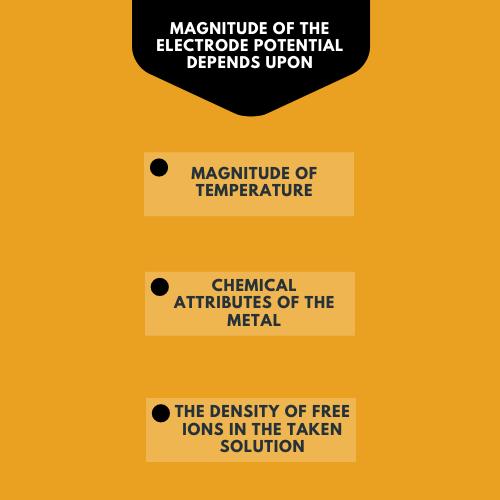Importance Of Electrochemical Series: A Detailed Analysis
Question
Task: Provide a detailed report over the importance of electrochemical series by relying on some practical examples.
Answer
Before discussing the importance of electrochemical series in this report we should first elaborate on what is electrochemical series. This series is also termed as activity series among the discipline of chemistry. The elements listed in the periodic table are arranged in such a way that it would signify the ascending order of the electrode potential values. The use of the standard hydrogen electrode is done to verify the potential of various electrodes.
It is based on the magnitude of the ability to undergo oxidation or reduction that various ions are being arranged to form an electrochemical series. It doesn't matter whether it is metal or non-metal. The value of the standard electrode potential is being calculated by accurately noting down the voltage at both the end of the standard hydrogen electrode when a half cell is connected to it. In the below section of this report on the importance of electrochemical series, the elaborate discussion over the electrochemical series chart, the importance of electrochemical series, the application of the theories in the electrochemical series is being discussed. We have also included some of the chemistry problems in the posterior section of this report on the importance of electrochemical series so that the concept of electrochemical series could be made well acquainted with our readers.

Electronegativity and electro positivity of the elements
The atoms of the elements which tend to give out the electrons or become positive ions while being in the form of the solution are termed to be the electropositive element. The element of hydrogen is an exception in this case. In this same manner, the elements which display the affinity to accept the electron and become negative ions are termed to be electronegative elements. These elements are all seen below the Hydrogen in an electrochemical series. If the electrochemical series is referred, it could be understood which elements would be interchanged in while two salts enter in a chemical reaction. It is the atom of hydrogen which is being replaced by the electropositive element in a chemical reaction.
Electrochemical Series chart
By referring to the electrochemical series chart, the link between the similar and different metals could be ascertained and evaluated in a very easy and effortless manner. Regardless of the factor of the atomic number and the mass number, some similarities would bind a group of elements together. The metals which are far apart in the electrochemical series would get suddenly gets corroded in the proximity of each other. Let us take an instance of both copper and zinc. They are the metals that are far apart in the electrochemical series and hence the chances of corrosion are far high if a copper vessel is coated using zinc. Please refer to the electrochemical series listed in the below section of this report.

The practical implication of electrochemical series
Oxidizing agent/ Reducing agent: By referring to the electrochemical series, you could easily understand whether the selected element is an oxidizing agent or a reducing agent. It should be noted that an element becomes much higher in oxidizing nature the higher it is found in the electrochemical series. The elements which are found in the higher section of the electrochemical series have a higher level of standard potential. Whereas the element which is observed to be at the bottom of the electrochemical series are excellent reducing agents. The same factor justifies their negative value of standard reduction potential. Let us take an instance of fluorine electrode which has a reduction potential value of +2.87 as mentioned in the electrochemical series. The value of +2.87 is considered to be a very strong reduction of potential value and makes it a very strong oxidizing agent. Whereas if the instance of lithium is taken into consideration it has the reduction potential value of -3.05 volts which tags it to the classification of the strong reducing agent.
How to calculate the standard emf of a particular electrochemical cell
To calculate the standard emf of an electrochemical cell the addition of both the values of the potentials at the end of the two half cells is done. One of the halves of the cell could be denoted as reduction half and the other part as the oxidation half cell. The representation could be denoted by the below-given equation.
E0cell = E0red + E0ox
As per a convention in the field of chemistry, it is the reduction potential which is always used to express the standard oxidation potential.
As per the above-mentioned context, the standard oxidation potential could be represented as (E0ox) = - standard reduction potential E0red.
In simple terms, it could be derived that,
E0cell = (The value of the standard reduction potential of reduction half-cell) – (Value of the reduction potential of oxidation half-cell)
The place where the process of reduction happens is termed to be a cathode and the place where the process of oxidation takes place is termed to be the anode. Thus, it could be stated that,
E0cell = E0cathode - E0anode
How to estimate the viability of the redox reaction
If there happens a free energy transaction that is negative, the redox reaction would take place. The change in energy could be termed by the symbol “?G”. The relation between the cell emf and free transaction of energy could be stated efficiently by the below-provided expression.
?Go = nFEo
Here the variable n denotes the number of electrons involved in the whole reaction. The variable F signifies the faraday constant and at last, the cell emf is denoted by the variable E0. Though you have to keep in mind some of the principles while considering the above expression.
- If the value of the variable E0 turns out to be negative than the reaction would not be in an immediate manner.
- If the value of the E0 happens to be positive then the ?Go would be negative.
- The instance when the value of E0 turns out to be positive the chemical reaction in the cell becomes spontaneous which implies that the source would generate electrical energy.
- To estimate the stability of the provided metallic salt, the numerical value of the E0 is very crucial for a redox reaction. The importance of this value increases when the particular salt is kept in proximity to another metal.
Estimating the final result of the electrolysis
Let us take an instance where more than one positive ion is present in the compound. It is based on the electrochemical character, that the metals get deposited on the electrodes as a comparison to the other metal. It is the ion with higher electro positivity or the character of having a higher oxidizing agent would get deposited on the electrode. It is on the cathode that these metals are deposited because of its high value of standard reduction potential.
Let us take an instance of aqueous common salt solution in which ions of Cl-, Na+, OH-, and H+ would be present. The process of reduction in the cathode would make possible the accumulation of Hydrogen ions or H+ there. Though it may be expected that the Na+ ion would get deposited because of its property of being reduced. The hydrogen gets most preferred in this case because of the higher reduction potential of the H+ (0.00 volt) which if compared to the reduction potential of Na+ (-2.71 volt) is much higher. The ions with lower reduction potentials which are termed to be the anions get deposited at the anode because of the oxidation process. The chance of getting oxidized would be much higher for the OH- ion and since it has the standard reduction potential of volt which is much higher than that of the volt of standard reduction potential for Cl- ion.
Some important concepts of the electrochemical series
Some of the major concepts of the electrochemical series are being described in the below section of this report on the importance of electrochemical series.
- The probability of being reduced would get higher for an element the higher the value of reduction potential would increase. Similarly, the elements possessing very less value of reduction potential would get oxidized very easily.
- The hydrogen scale is taken as a parameter in the electrochemical series, to determine the reduction potential of a certain element. In this scale, the E0 is considered to be of value 0. The affinity or the tendency of the selected element to undergo the process of reduction could be termed as the standard reduction potential in the field of chemistry.
- The elements having a negative standard reduction could be tagged as a very strong reducing agent. Such elements are observed to be below the hydrogen in the electrochemical series. The term higher reduction potential or positive reduction potential of an element signifies its readiness to accept the electrons and obstinacy in giving away the electrons simultaneously.
- As the element goes down towards the bottom in the electrochemical series, the reaction rate of the metal or the electro positivity of the element increases gradually. Though if the substance is observed to be a non-metal, its reaction rate would decrease gradually to the bottom course.
- Similarly, as mentioned in the above-listed point, the strength of the oxidizing agent would decrease downwards, though the case is opposite in the case of the reducing agent. The power of the reducing agent would increase when moved to the downward course of the electrochemical series.
By reading the content provided in the above section of this report on the Importance of electrochemical series, you could have understood that the arrangement of the elements based on the increasing value of reduction electrode potential is termed to be the electrochemical series. If taken the case of hydrogen element, the value of its standard reduction potential is zero. It is the basic parameter or the point of segregation between the reducing and oxidizing agents. The elements which are situated above to the position of hydrogen have negative reduction potential, though the elements which are situated below it have a positive value of reduction potential. The process and principle behind the standard reduction potential, reduction, and oxidation should be understood by the reader to understand the importance of electrochemical series both in a practical and academic scenario.
The section of electrochemistry majorly deals with an articular section of chemistry, which defines the major chemical phenomenon that leads to the passage of electricity into the system in which it is contained. These phenomena are mostly redox reactions. By the term redox reaction, it is intended to signify that both the process of reduction and oxidation would happen in the same system simultaneously.
The major concept behind the process of reduction and oxidation
If in a particular scenario or the chemical reaction, the electrons are lost from an atom or an ion, the process would be termed as oxidation as per the electrochemical concept. The process of oxidation is also termed as de-electronation occasionally. Though it should not be confused that the electron losing particle is termed to be the reducing agent.
Similar to the above-mentioned concept, the process in which the element gains the electron is termed as reduction. Its process is also known as electronation. By the process of electronation, there happens a dip in the positive valency ins surge in the negative valency. The element which accepts the electron in the process of reduction is called the oxidizing agent.
Electrode potential
The voltage difference or the potential difference between two electrodes and the associated ions in the solution could be termed as the electrode potential. The magnitude of the electrode potential would depend on various factors that are listed in the below section of this article on the Importance of the electrochemical series.

- Magnitude of Temperature
- Chemical attributes of the metal.
- The density of free ions in the taken solution.
Various types of electrode potential
Reduction potential: The affinity of the selected electrode to receive an electron and undergo the process of reduction is measured using the reduction potential.
Oxidation potential: The affinity of an element to give away electrons and become a positive ion could be stated as oxidation potential.
Methodology to measure and quantify the standard electrode potential, E0
The tendency to accept or give away the electron which is also termed as the standard electrode potential of an electrode when it is placed inside or in proximity with the electrolyte could not be measured accurately while considering it as a half cell. The reasons for this are described in the below section of this report on the Importance of the electrochemical series.
Though the section where the electrodes are dipped into the electrolyte is considered to be half-cell, they could not though work as an independent unit. They could only work as the system if both halves are in the same system.
Though we have described that various elements display the tendency to accept or lose the electrons, though it is only the factor of comparison. The tendencies are compared to each other and even some times less electronegative elements end up in giving out an electron to very high electronegative elements.
These are the major factors that would prohibit us from estimating the actual standard electrode potential to its precise level. The use of the reference electrode should be done to measure the value. It is important to allocate an arbitrary electrode potential to the newly introduced electrode into the system. It is the standard hydrogen electrode which is used majorly as the reference electrode. This electrode is also termed as a normal hydrogen electrode. As mentioned in the previous section of this report on the importance of electrochemical series, the value of standard electrode potential for hydrogen is taken as zero which is similar in the case of standard hydrogen electrode.
As mentioned earlier, the standard hydrogen electrode is introduced as the reference electrode in the system which serves the cause for measuring the standard electrode potential of the electrode. The electrode whose standard electrode potential is to be calculated is kept in one half of the cell and the other half is being occupied by the standard electron potential. It is after this set up that the product of the redox reaction is measured by using the instrument of high resistance voltmeter. The reading could be made more accurate by using the potentiometer.
If the needle of the voltmeter would get deflected, the presence of electricity could be ascertained. The direction of the electricity flow could be observed to be in the opposite direction. The direction of the voltmeter needle is towards the metal electrode to be checked; it would imply that the current is flowing towards the standard hydrogen electrode. In most cases, the standard hydrogen electrode would behave like a cathode and the other electrode as an anode, provide that it is a metallic electrode. If the deflection of the meter is towards the metallic electrode, then the flow of current is from the hydrogen electrode to the metal electrode. The role of anode would be acquired by hydrogen electrode in this case and hence the cathode would be the electrode situated at the other half of the cell. From this context, the blow provided expression could be derived out.
E0 cell = E0 cathode - E0 anode
The variable of E0 represents the value of standard reduction potential.
It is by taking into reference the standard electrode potential of the electrode that the variable of E0 is calculated.
Major implications of the electrochemical series
By utilizing the electrochemical series, the elements which are excellent reducing agents and oxidizing agents could be identified. The reducing power of the element would keep on reducing when it moves further upwards from the position of hydrogen, though the reduction capacity would increase the downward it goes with respect to the position of hydrogen. The element of Lithium has the least value for the variable E0 and hence the energy required to reduce the element is very high. It is a very strong reducing agent since it has a high affinity to give out the electron.
The type of elements which have a higher tendency of entering in the reduction reaction is placed below hydrogen in the electrochemical series. The value of E0 would be positive in the cases of elements which are placed below hydrogen in the electrochemical series. Hence the redox reaction could be easily predicted by referring to the electrochemical series.
The higher the positive value of E0 is detected for an element, the higher would be the oxidizing power for it in a chemical reaction.












